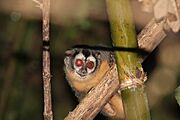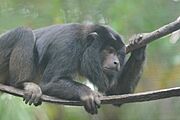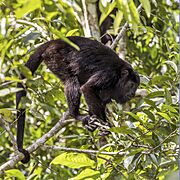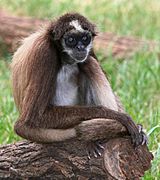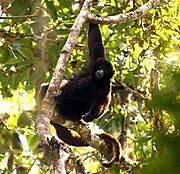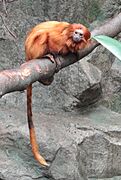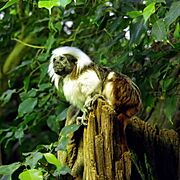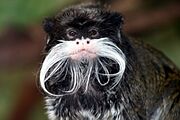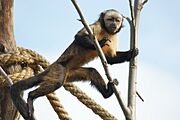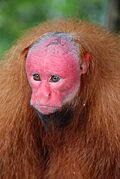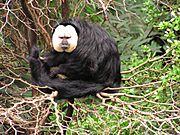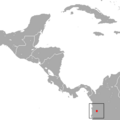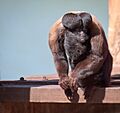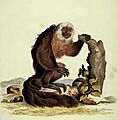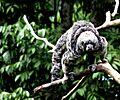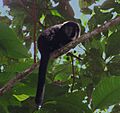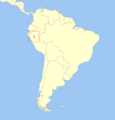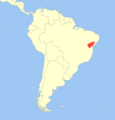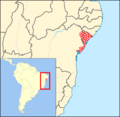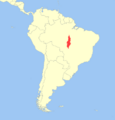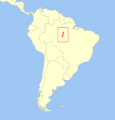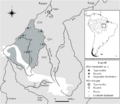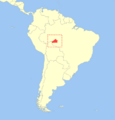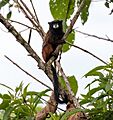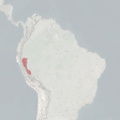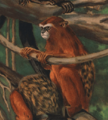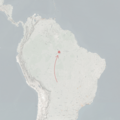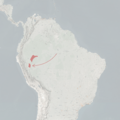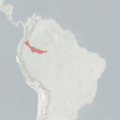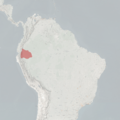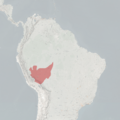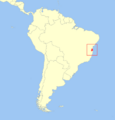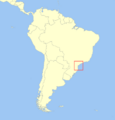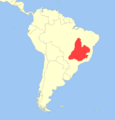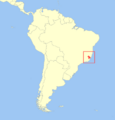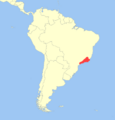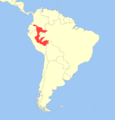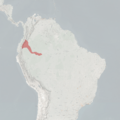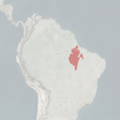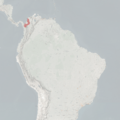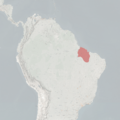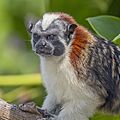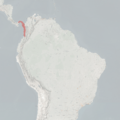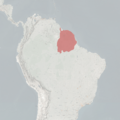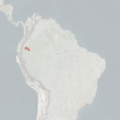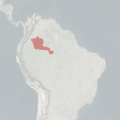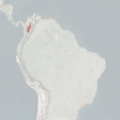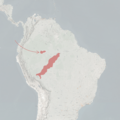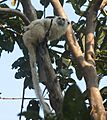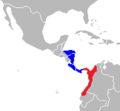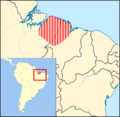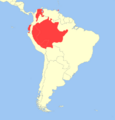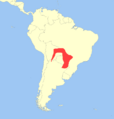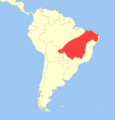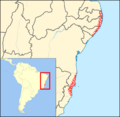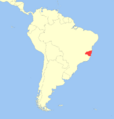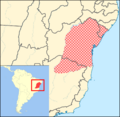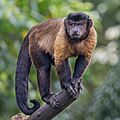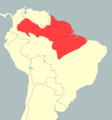List of platyrrhines facts for kids
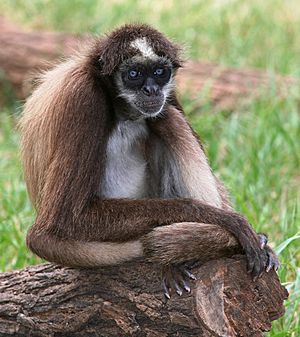
Platyrrhini is a group of primates often called New World monkeys. These amazing animals include marmosets, tamarins, capuchins, squirrel monkeys, night monkeys, titi monkeys, saki monkeys, howler monkeys, spider monkeys, and woolly monkeys. They live in the forests and savannas of South and Central America.
New World monkeys come in many sizes! The smallest is the western pygmy marmoset, which is only about 12 centimeters (5 inches) long, plus its tail. The largest are some types of howler monkeys, which can be up to 92 centimeters (36 inches) long, with a tail just as long. These monkeys mostly eat fruit, leaves, and insects. Many New World monkey species are in danger; 21 species are listed as endangered, and 14 are critically endangered, meaning they are at very high risk of disappearing forever.
Contents
What Are New World Monkeys?
There are 160 different types of New World monkeys alive today. Scientists divide them into five main groups, called families:
- Aotidae (Night monkeys)
- Atelidae (Howler, spider, and woolly monkeys)
- Callitrichidae (Marmosets and tamarins)
- Cebidae (Capuchin and squirrel monkeys)
- Pitheciidae (Titi, uakari, and saki monkeys)
Each family has different kinds of monkeys, called genera, and each genus has its own species. For example, the Aotidae family has one genus, Aotus, which includes eleven different night monkey species.
Meet the Monkey Families
Let's explore some of the amazing New World monkeys!
Night Monkeys (Family Aotidae)
Night monkeys are special because they are the only monkeys that are active at night! They have big eyes to help them see in the dark.
| Common name | Scientific name and subspecies | Range | Size and ecology | IUCN status and estimated population |
|---|---|---|---|---|
| Azara's night monkey | A. azarae {{{authority-name}}}, {{{authority-year}}} |
Central and northeastern South America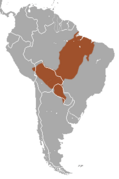 |
Size: 24–37 cm (9–15 in) long, plus 31–40 cm (12–16 in) tail Habitat: Forest and savanna Diet: Fruit, nectar, flowers, insects, and other small animals |
LC
|
| Peruvian night monkey | A. miconax {{{authority-name}}}, {{{authority-year}}} |
Northwestern South America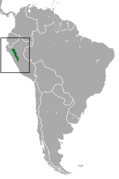 |
Size: 24–37 cm (9–15 in) long, plus 31–40 cm (12–16 in) tail Habitat: Forest Diet: Fruit, flowers, leaves, buds, and insects |
EN
|
Howler, Spider, and Woolly Monkeys (Family Atelidae)
This family includes some of the largest New World monkeys. Howler monkeys are famous for their loud calls! Spider monkeys have very long arms and tails, which help them swing through trees.
Howler Monkeys (Genus Alouatta)
| Common name | Scientific name and subspecies | Range | Size and ecology | IUCN status and estimated population |
|---|---|---|---|---|
| Black howler | A. caraya {{{authority-name}}}, {{{authority-year}}} |
Central South America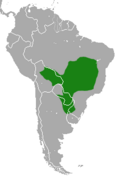 |
Size: 51–67 cm (20–26 in) long, plus 51–67 cm (20–26 in) tail Habitat: Forest and savanna Diet: Leaves, fruit, buds, and flowers |
NT
|
| Yucatán black howler | A. pigra {{{authority-name}}}, {{{authority-year}}} |
Yucatán Peninsula in Mexico and Central America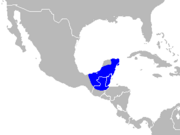 |
Size: 52–71 cm (20–28 in) long, plus 50–69 cm (20–27 in) tail Habitat: Forest Diet: Fruit, leaves, buds, and flowers |
EN
|
Spider and Woolly Monkeys (Genus Ateles and Lagothrix)
| Common name | Scientific name and subspecies | Range | Size and ecology | IUCN status and estimated population |
|---|---|---|---|---|
| Brown spider monkey | A. hybridus {{{authority-name}}}, {{{authority-year}}} |
Northwestern South America |
Size: 45–50 cm (18–20 in) long, plus 74–81 cm (29–32 in) tail Habitat: Forest Diet: Fruit, leaves, flowers, seeds, bark, honey, decaying wood, termites, and caterpillars |
CR
|
| Common name | Scientific name and subspecies | Range | Size and ecology | IUCN status and estimated population |
|---|---|---|---|---|
| Yellow-tailed woolly monkey | L. flavicauda {{{authority-name}}}, {{{authority-year}}} |
Western South America | Size: 44–53 cm (17–21 in) long, plus 60–65 cm (24–26 in) tail Habitat: Forest Diet: Fruit, leaves, insects, moss, buds, and flowers |
CR
|
Marmosets and Tamarins (Family Callitrichidae)
These are some of the smallest New World monkeys. They are known for their long tails and often have unique fur patterns.
Marmosets (Genus Callithrix and Cebuella)
| Common name | Scientific name and subspecies | Range | Size and ecology | IUCN status and estimated population |
|---|---|---|---|---|
| Common marmoset | C. jacchus {{{authority-name}}}, {{{authority-year}}} |
Eastern South America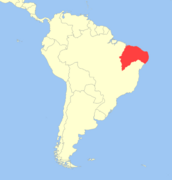 |
Size: 12–15 cm (5–6 in) long, plus 29–35 cm (11–14 in) tail Habitat: Forest and savanna Diet: Tree sap, insects, spiders, fruit, flowers, nectar, small lizards, bird's eggs, nestlings, and frogs |
LC
|
| Common name | Scientific name and subspecies | Range | Size and ecology | IUCN status and estimated population |
|---|---|---|---|---|
| Western pygmy marmoset | C. pygmaea {{{authority-name}}}, {{{authority-year}}} |
Western South America | Size: 12–15 cm (5–6 in) long, plus 17–23 cm (7–9 in) tail Habitat: Forest Diet: Tree gum, sap, resin, insects, small lizards, fruit, flowers, and spiders |
VU
|
Lion Tamarins (Genus Leontopithecus)
These tamarins have a mane of fur around their faces, like a lion! They are very rare.
| Common name | Scientific name and subspecies | Range | Size and ecology | IUCN status and estimated population |
|---|---|---|---|---|
| Golden lion tamarin | L. rosalia {{{authority-name}}}, {{{authority-year}}} |
Southeastern South America |
Size: 20–37 cm (8–15 in) long, plus 31–40 cm (12–16 in) tail Habitat: Forest Diet: Spiders, snails, small lizards, eggs, small birds, fruit, and vegetables |
EN
|
Other Tamarins (Genus Saguinus)
| Common name | Scientific name and subspecies | Range | Size and ecology | IUCN status and estimated population |
|---|---|---|---|---|
| Cotton-top tamarin | S. oedipus {{{authority-name}}}, {{{authority-year}}} |
Northwestern South America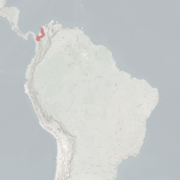 |
Size: 20–25 cm (8–10 in) long, plus 33–40 cm (13–16 in) tail Habitat: Forest Diet: Insects, fruit, and gum |
CR
|
| Emperor tamarin | S. imperator {{{authority-name}}}, {{{authority-year}}} |
Western South America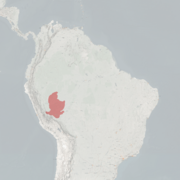 |
Size: 23–27 cm (9–11 in) long, plus 35–43 cm (14–17 in) tail Habitat: Forest Diet: Fruit, insects, tree sap, lizards, tree frogs, and bird eggs |
LC
|
Capuchin and Squirrel Monkeys (Family Cebidae)
Capuchin monkeys are very smart and can use tools. Squirrel monkeys are small and quick, often seen in large groups.
Capuchin Monkeys (Genus Cebus and Sapajus)
| Common name | Scientific name and subspecies | Range | Size and ecology | IUCN status and estimated population |
|---|---|---|---|---|
| Wedge-capped capuchin | C. olivaceus {{{authority-name}}}, {{{authority-year}}} |
Northern South America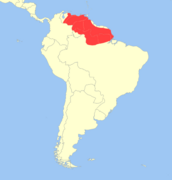 |
Size: 37–46 cm (15–18 in) long, plus 40–55 cm (16–22 in) tail Habitat: Forest Diet: Fruit, palm nuts, seeds, berries, small vertebrates, and invertebrates |
LC
|
| Common name | Scientific name and subspecies | Range | Size and ecology | IUCN status and estimated population |
|---|---|---|---|---|
| Golden-bellied capuchin | S. xanthosternos {{{authority-name}}}, {{{authority-year}}} |
Eastern South America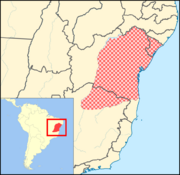 |
Size: 35–49 cm (14–19 in) long, plus 37–49 cm (15–19 in) tail Habitat: Forest, savanna, and shrubland Diet: Fruit, seeds, nectar, pith, stems, nuts, berries, flowers, leaves, bird eggs, insects, frogs, small reptiles, birds, bats, other small mammals, oysters, and crabs |
CR
|
Squirrel Monkeys (Genus Saimiri)
| Common name | Scientific name and subspecies | Range | Size and ecology | IUCN status and estimated population |
|---|---|---|---|---|
| Guianan squirrel monkey | S. sciureus {{{authority-name}}}, {{{authority-year}}} |
Northern South America (in green) |
Size: About 32 cm (13 in) long, plus 41 cm (16 in) tail Habitat: Forest Diet: Fruit and insects, as well as leaves and seeds |
LC
|
Titi, Uakari, and Saki Monkeys (Family Pitheciidae)
This family includes monkeys with long, bushy tails like titi monkeys, and uakaris, which have very short tails and often bright red faces. Saki monkeys are known for their thick, shaggy fur.
Titi Monkeys (Genus Plecturocebus)
| Common name | Scientific name and subspecies | Range | Size and ecology | IUCN status and estimated population |
|---|---|---|---|---|
| Coppery titi monkey | P. cupreus {{{authority-name}}}, {{{authority-year}}} |
Western South America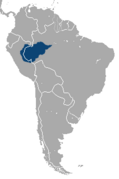 |
Size: 28–39 cm (11–15 in) long, plus 7–13 cm (3–5 in) tail Habitat: Forest Diet: Fruit pulp, leaves, insects and seeds |
LC
|
Uakaris (Genus Cacajao)
| Common name | Scientific name and subspecies | Range | Size and ecology | IUCN status and estimated population |
|---|---|---|---|---|
| Bald uakari | C. calvus {{{authority-name}}}, {{{authority-year}}} |
Western South America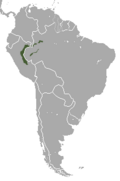 |
Size: 38–57 cm (15–22 in) long, plus 14–19 cm (6–7 in) tail Habitat: Forest Diet: Seeds, fruit, leaves, nectar, and insects |
VU
|
Saki Monkeys (Genus Pithecia)
| Common name | Scientific name and subspecies | Range | Size and ecology | IUCN status and estimated population |
|---|---|---|---|---|
| White-faced saki | P. pithecia {{{authority-name}}}, {{{authority-year}}} |
Northern South America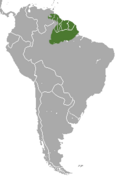 |
Size: 28–46 cm (11–18 in) long, plus 32–46 cm (13–18 in) tail Habitat: Forest Diet: Seeds, leaves, insects and flowers |
LC
|
Images for kids


